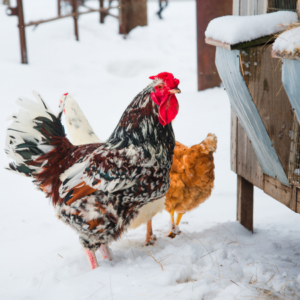 Raising chickens in winter can be a lot of fun. Some hens love wandering around the yard and their first snow sighting can be quite entertaining. A bird’s thick feathers are a natural protective coat. As a result, most breeds are well-equipped for winter.
Raising chickens in winter can be a lot of fun. Some hens love wandering around the yard and their first snow sighting can be quite entertaining. A bird’s thick feathers are a natural protective coat. As a result, most breeds are well-equipped for winter.
Here are a few tips on how to care for chickens in the winter:
-
-
- How to keep chickens warm in winter:
Do not add heat lamps. Chickens, especially cold-tolerant breeds, can withstand winter temperatures without supplemental heat. A chicken’s body temperature is around 106 degrees Fahrenheit, and they have their own protective layer of feathers to keep them warm.Most importantly, if you feel it is necessary to provide a source of heat, only provide enough heat to raise the temperature a few degrees. The hens will adjust to the cold temperature, but if it is 70 degrees Fahrenheit in the coop and 0 degrees Fahrenheit in the run, birds will not be able to regulate their body temperature. - What to feed chickens in winter:
A common myth is to feed oatmeal to birds in the winter. This is not a beneficial treat for chickens. Oats contain some types of fiber that chickens can’t digest which can cause the contents of the digestive tract to thicken. This leads to a reduction in the bird’s ability to digest and absorb nutrients. Greens are also unnecessary. Hens may pick at hay and spread it around, but they are not going to eat it.Feeding a complete layer feed like Purina® Layena®, Purina® Layena® Plus Omega-3 or Purina® Organic Pellets or Crumbles will provide the necessary nutrition hens need through the winter. - Ensure feed and water isn’t frozen.
Consider heated waterers. Feed and water birds more often when it’s below freezing. Energy needs increase in winter. Animals expend a considerable amount of energy to stay warm and will eat more feed. Complete layer feeds include all the energy hens need. The 90/10 rule still applies in winter. - Allow exploration.
Firstly, birds can tolerate snow, cold air and ice water. There is very little muscle in the lower part of bird legs and feet. Tendons control the movements. They stretch from the upper part of the legs down to the toes. Secondly, the blood entering the lower legs and feet are cooled by the blood returning to the heart. The blood going to the toes warms the blood returning. As a result, the tissue receives just enough heat to avoid frostbite while also being provided with enough oxygen to keep things functioning. - Collect eggs more frequently.
Temperatures below freezing result in frozen eggs. Moreover, as the egg freezes, the contents expand and will cause the egg to crack. - Keep the chicken coop draft free.
But don’t seal it completely. Exchange air to prevent ammonia build up. Open the top vent or higher windows slightly so fresh air can enter and stale air can exit. - Keep the chicken coop dry.
Remove any wet spots daily. Provide more bedding than you would in other seasons so birds have a place to burrow and stay cozy. - Continue offering activities in the chicken coop.
Hens will spend more time in the coop, so offer enrichment. For example, logs, sturdy branches or chicken swings can work well and place a Purina® Flock Block® supplement in the coop for a nutritious place to peck.
- How to keep chickens warm in winter:
-
In conclusion, visit D&D Feed & Supply to treat your flock! Check out our poultry feed selection here.
Article Source: Purina Mills
Ready to see the difference a complete feed can make in your flock? Sign up for Purina’s Feed Greatness® Challenge.
